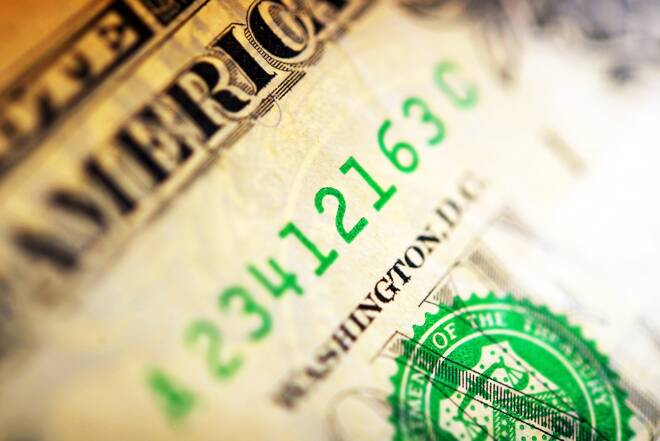Advertisement
Advertisement
The Weekly Wrap – Monetary Policy and Economic Woes Drive Dollar Demand
By:
Fears of an economic recession and market jitters ahead of the Fed's monetary policy decision on Wednesday drives the greenback northwards.
The Stats
It was a busy week on the economic calendar for the week ending April-29, 2022.
A total of 56 stats were monitored, following 57 stats in the week prior.
Of the 56 stats, 26 beat forecasts, with 26 economic indicators falling short of forecasts. 4 stats were in line with forecasts.
Looking at the numbers, 30 of the stats reflected an upward trend. Of the remaining 26 stats, 25 stats were weaker.
Out of the US
Core durable goods orders and consumer sentiment drew interest on Tuesday. The stats were market positive, with core durable goods orders rising by 1.1% in March.
Consumer sentiment held steady in April, which was also market positive. The CB Consumer Confidence Index slipped from 107.6 to 107.3.
On Thursday, US GDP numbers disappointed, however, with the US economy contracting by 1.4%. In the previous quarter, the economy expanded by 6.9%.
At the end of the week, inflation and personal spending were market positive. Personal spending rose by 1.1% in March, while inflationary pressures softened. The Core PCE Price Index increased by 5.2% year on year in March, down from 5.3% in February.
In the week ending April 29, 2022, the Dollar Spot Index surged by 1.72% to end the week at 102.959. In the week prior, the Index rose by 0.72% to 101.22.
Out of the UK
It was a particularly quiet week, with stats limited to CBI Industrial Trend Orders. In April. Industrial Trend Orders fell from 26 to 14, which was Pound negative.
Risk aversion and market sentiment towards Fed monetary policy ultimately left the Pound deep in the red.
In the week, the Pound tumbled by 2.07% to end the week at $1.2573. In the week prior, the Pound slid by 1.69% to $1.2839.
The FTSE100 ended the week up 0.30%, partially reversing a 1.24% loss from the previous week.
Out of the Eurozone
Early in the week, German business and consumer sentiment diverged. While business sentiment improved, consumer sentiment weakened further.
The Ifo Business Climate Index increased from 90.8 to 91.8 in April, while the Gfk German Consumer Climate Index fell from -15.7 to -26.5.
In the second half of the week, the market focus shifted to inflation and economic growth.
The stats were market positive, with German and the Eurozone GDP numbers for the first quarter providing support.
In Q1 2022, the German economy expanded by 4.0% year on year, up from 1.8% in the previous quarter.
The Eurozone’s economy grew by 5.0% year on year, up from 4.6% in the quarter prior.
On the inflation front, inflationary pressures ticked up further, though only moderately. According to prelim figures, the Eurozone’s annual rate of inflation picked up from 7.4% to 7.5%.
For the week, the EUR slumped by 2.27% to $1.0545. In the previous week, the EUR fell by 0.19% to $1.0790.
The CAC40 fell by 0.73%, with the EuroStoxx600 and the DAX seeing losses of 0.64% and 0.31%, respectively.
For the Loonie
It was also a quiet week, with economic data limited to February GDP numbers.
While Loonie positive, the numbers had a muted impact on the Loonie following the latest Bank of Canada rate hike.
In February, the economy grew by 1.1%, accelerating from 0.2% growth in January.
In the week ending April-29, the Loonie slid by 1.09 to C$1.2848 against the Greenback. The Loonie fell by 0.79% to C$1.2710 in the week prior.
Elsewhere
It was yet another bearish week for the Aussie Dollar and the Kiwi Dollar.
The Aussie Dollar tumbled by 2.53% to $0.7061, with the Kiwi Dollar sliding by 2.73% to end the week at $0.6458.
For the Aussie Dollar
Inflation was in focus mid-week.
The stats were Aussie Dollar positive, supporting a near-term RBA move on cash rates. Monetary policy divergence remained strongly in favor of the Greenback, however.
In Q1, Australia’s annual rate of inflation accelerated from 3.5% to 5.1%. Wholesale inflationary pressure also picked up, with the annual wholesale rate of inflation accelerating from 3.7% to 4.9%.
For the Kiwi Dollar
Trade data and business confidence were in focus in the week, with the stats Kiwi dollar negative.
In March, New Zealand’s trade deficit widened from NZ$8,680m to NZ$9,110m.
The ANZ Business confidence slipped from -41.9 to -42.0 in April.
For the Japanese Yen
On the economic data front, industrial production and retail sales figures for March were in focus. The stats were Yen negative.
Industrial production increased by a modest 0.3% after rising by 2.0% in February.
Retail sales provided some relief, rising by 0.3% year on year. In February, retail sales declined by 0.9%.
On the monetary policy front, the Bank of Japan was also in action, though there were no surprises to support the Yen.
The Japanese Yen fell by 0.93% to end the week at ¥129.70 against the Dollar. In the week prior, the Yen ended the week down by 1.61% to ¥128.50.
Out of China
It was a particularly quiet week, with no economic data from China to influence market risk sentiment.
In the week ending April-29, the Chinese Yuan slid by 1.65% to CNY6.6085. The Yuan tumbled by 2.04% to CNY6.5014 in the week prior.
The Hang Seng Index ended the week up 2.18%, with the CSI300 gaining by 0.07%.
About the Author
Bob Masonauthor
With over 28 years of experience in the financial industry, Bob has worked with various global rating agencies and multinational banks. Currently he is covering currencies, commodities, alternative asset classes and global equities, focusing mostly on European and Asian markets.
Advertisement
